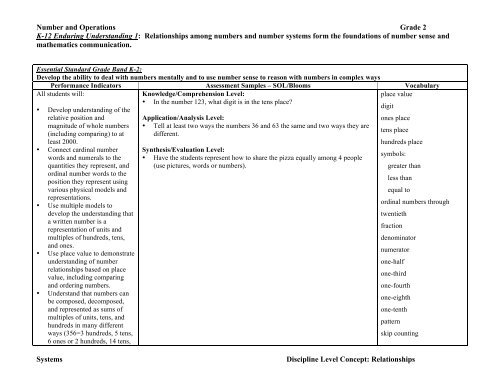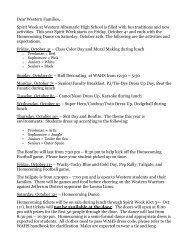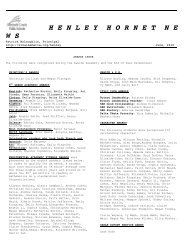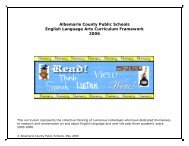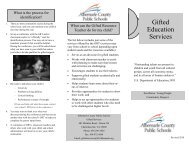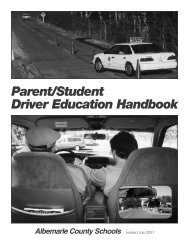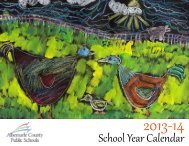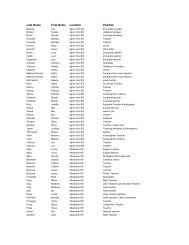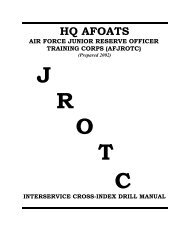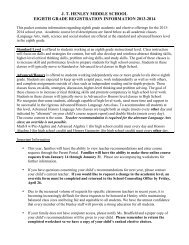Number and Operations Grade 2 K-12 Enduring Understanding 1 ...
Number and Operations Grade 2 K-12 Enduring Understanding 1 ...
Number and Operations Grade 2 K-12 Enduring Understanding 1 ...
- No tags were found...
Create successful ePaper yourself
Turn your PDF publications into a flip-book with our unique Google optimized e-Paper software.
Geometry <strong>and</strong> Measurement Str<strong>and</strong> <strong>Grade</strong> 2Mathematics <strong>Enduring</strong> Underst<strong>and</strong>ing 2: Spatial relationships can be described using coordinate geometry <strong>and</strong> other representationalsystems.Essential St<strong>and</strong>ard <strong>Grade</strong> B<strong>and</strong> K-2:Describe, name, <strong>and</strong> interpret relative positions, directions, <strong>and</strong> distances in spacePerformance Indicators Assessment Samples – SOL/Blooms VocabularyAll students will:Knowledge/Comprehension Level:left• Give students a map of the school. Have the students draw theshortest route for the principal to go to the classroom.right• Underst<strong>and</strong> that direction<strong>and</strong> distance can be used innavigating space.Application/Analysis Level:• “Tanya the Turtle” (Investigations in <strong>Number</strong>, Data, <strong>and</strong> Space, “HowLong, How Far?”)Tanya the Turtle is hungry <strong>and</strong> tired. She wants to have a snackbefore going back to her lily pad. She knows where two flies arein the pond. Using the grid below, list the moves Tanya mustmake to get the two flies <strong>and</strong> then go back to her lily pad for arest.northsoutheastwestSystemsDiscipline Level Concept: Relationships
Geometry <strong>and</strong> Measurement Str<strong>and</strong> <strong>Grade</strong> 2Mathematics <strong>Enduring</strong> Underst<strong>and</strong>ing 2: Spatial relationships can be described using coordinate geometry <strong>and</strong> other representationalsystems.Synthesis/Evaluation Level:• “Andy the Ant” (Investigations in <strong>Number</strong>, Data, <strong>and</strong> Space, “HowLong, How Far?”)Supporting Skills <strong>and</strong> Processes: Using directional vocabulary <strong>and</strong> working with gridsSystemsDiscipline Level Concept: Relationships
Geometry <strong>and</strong> Measurement Str<strong>and</strong> <strong>Grade</strong> 2Mathematics <strong>Enduring</strong> Underst<strong>and</strong>ing 3: Attributes of objects can be measured using processes <strong>and</strong> quantified units, <strong>and</strong> usingappropriate techniques, tools, <strong>and</strong> formulas.Essential St<strong>and</strong>ard <strong>Grade</strong> B<strong>and</strong> K-2:Underst<strong>and</strong>ing attributes of measurement by directly comparing objects, <strong>and</strong> selecting an appropriate unit <strong>and</strong> toolsPerformance Indicators Assessment Samples – SOL/Blooms VocabularyAll students will:cent symbolKnowledge/Comprehension Level:• Ask the student to write $3.49. Look for the correct use of the dollardollar symbolsign/decimal.decimal point• Underst<strong>and</strong> that objectscan be ordered bymeasurable attributes,including length,weight/mass, volume,value, time <strong>and</strong>temperature.• Underst<strong>and</strong> that thereare tools that measurespecific attributes.• Measure using nonst<strong>and</strong>ard<strong>and</strong> st<strong>and</strong>ardunits length, liquidvolume, weight,temperature, <strong>and</strong> time(to the nearest 5minutes).• Select an appropriateunit <strong>and</strong> tool for theattribute beingmeasured.• Count or compare acollection of coinswhose total value is$2.00 or less, using thecorrect symbols.Application/Analysis Level:• Calendar Interpretation:Use the calendar to answer the questions:Five days after March 16 is what day?Three days before March 25 is what day?What will be the date one week from March 30?greater thanless thanequal toinchcentimeterdistancesurfacesquare unitsvolumeweightmasspoundkilogramquarter houranalog clockdigital clockliquid volumecupscent symbolSystemsDiscipline Level Concept: Quantifying Representation
Geometry <strong>and</strong> Measurement Str<strong>and</strong> <strong>Grade</strong> 2Mathematics <strong>Enduring</strong> Underst<strong>and</strong>ing 3: Attributes of objects can be measured using processes <strong>and</strong> quantified units, <strong>and</strong> usingappropriate techniques, tools, <strong>and</strong> formulas.Synthesis/Evaluation Leveldollar symbolArea <strong>and</strong> PerimeterEach small square on the gird provided is one square unit.decimal pointgreater than• Create a design that meets these criteria:o (1) covers <strong>12</strong> square unitsless thano (2) the distance around the figure is 16 unitsequal toinchcentimeterdistancesurfacesquare unitvolumeweightmasspoundkilogramquarter houranalog clockdigital clockliquid volumepintquartgallonliterequivalentmonthSystemsDiscipline Level Concept: Quantifying Representation
Geometry <strong>and</strong> Measurement Str<strong>and</strong> <strong>Grade</strong> 2Mathematics <strong>Enduring</strong> Underst<strong>and</strong>ing 11: Analyze characteristics <strong>and</strong> properties of 2- <strong>and</strong> 3-dimensional geometric shapes <strong>and</strong> developmathematical arguments about geometric relationshipsCommunicationDiscipline Level Concept: Reasoning <strong>and</strong> Justification
Geometry <strong>and</strong> Measurement Str<strong>and</strong> <strong>Grade</strong> 2Mathematics <strong>Enduring</strong> Underst<strong>and</strong>ing 11: Analyze characteristics <strong>and</strong> properties of 2- <strong>and</strong> 3-dimensional geometric shapes <strong>and</strong> developmathematical arguments about geometric relationshipsSOL: 2.16 The student will identify, describe, compare, <strong>and</strong> contrast plane <strong>and</strong> solid geometric figures (circle/sphere, square/cube, <strong>and</strong>rectangle/rectangular prism).CommunicationDiscipline Level Concept: Reasoning <strong>and</strong> Justification
Geometry <strong>and</strong> Measurement Str<strong>and</strong> <strong>Grade</strong> 2Mathematics <strong>Enduring</strong> Underst<strong>and</strong>ing <strong>12</strong>: Transformations, symmetry, <strong>and</strong> spatial reasoning can be used to analyze <strong>and</strong> modelmathematical situations.Essential St<strong>and</strong>ard <strong>Grade</strong> B<strong>and</strong> K-2:Develop an underst<strong>and</strong>ing of transformations <strong>and</strong> symmetry with shapesPerformance Indicators Assessment Samples – SOL/Blooms VocabularyAll students will:Knowledge/Comprehension Level:• Recognize, name, build, • Draw the lines of symmetry for each shape or letter.draw, compare, <strong>and</strong> sort2D <strong>and</strong> 3D shapes.line of symmetryverticalhorizontalApplication/Analysis Level:• Look at the cutout in the drawingdiagonal• Draw a picture of what the paper will look like when it is unfolded.CommunicationDiscipline Level Concept: Reasoning <strong>and</strong> Justification
Data Analysis <strong>and</strong> Probability <strong>Grade</strong> 2Mathematics <strong>Enduring</strong> Underst<strong>and</strong>ing 5: Mathematical models are used to predict <strong>and</strong> make inferences about data.Essential St<strong>and</strong>ard <strong>Grade</strong> B<strong>and</strong> K-2: Discuss events related to student experiences by conducting surveys <strong>and</strong> reading graphs of studentinformationPerformance Indicators Assessment Samples – SOL/Blooms VocabularyAll students will:Knowledge/Comprehension levelShow students a weather graphs for the months of February, April, May, more! Underst<strong>and</strong> that they can August, <strong>and</strong> December. Ask questions about the number of sunny daysgather data aboutthemselves <strong>and</strong> theirsurrounding in order toanswer questions.comparing one month to another.lessfewer! Underst<strong>and</strong> that the datagathered <strong>and</strong> analyzedfrom observations <strong>and</strong>surveys can have animpact on our everydaylives.greater thanless thanequal to! Underst<strong>and</strong> <strong>and</strong> constructpicture graphs, objectgraphs, <strong>and</strong> bar graphs torepresent data <strong>and</strong> answerquestions.picture graphsbar graphsdata! Underst<strong>and</strong> thatinterpretation of the datacould lead to additionalquestions to becompareinvestigated.Application /Analysis levelStudents will collect temperature data for a month, <strong>and</strong> then display the datain a graph.Synthesis/Analysis levelStudents will make an observation about their data, <strong>and</strong> write a letter to nextyear’s second graders informing them what clothing they should haveProperties <strong>and</strong> ModelsDiscipline Level Concept: Models
Data Analysis <strong>and</strong> Probability <strong>Grade</strong> 2Mathematics <strong>Enduring</strong> Underst<strong>and</strong>ing 5: Mathematical models are used to predict <strong>and</strong> make inferences about data.prepared for that month.Supporting SOL2.23 The student will read, construct, <strong>and</strong> interpret a simple picture <strong>and</strong> bar graph.Properties <strong>and</strong> ModelsDiscipline Level Concept: Models
Data Analysis <strong>and</strong> Probability Str<strong>and</strong> <strong>Grade</strong> 2Mathematics <strong>Enduring</strong> Underst<strong>and</strong>ing 6: Data can be collected, organized, <strong>and</strong> displayed in purposeful ways.Essential St<strong>and</strong>ard <strong>Grade</strong> B<strong>and</strong> K-2: Pose questions, gather, <strong>and</strong> use various methods to represent data about themselves <strong>and</strong> theirsurroundingsPerformance Indicators Assessment Samples – SOL/Blooms VocabularyAll students will:Use the following activity for the assessments:• Vary, Vary Interesting Things (Exploring Statistics in the graph! Underst<strong>and</strong> <strong>and</strong> construct picture Elementary <strong>Grade</strong>s, Dale Seymour)graphs, object graphs, <strong>and</strong> bargraphs to represent data <strong>and</strong>answer questions.Fill bundles or containers with a wide variety of materials, suchas wallpaper samples, buttons, fabric swatches, alphabet letters,attribute blocks, catalog pictures of tools, jewelry, or hats (onebundle per group of 3 or 4 students).constructcollectIt is always interesting to see how other people organize things.You will be working in small groups <strong>and</strong> analyzing materials ina bag or bundle.Knowledge/Comprehension level1. What is in your bag (or bundle)?2. How can these materials be sorted?3. Choose one sorting factor (attribute) to sort your bundle.organizedisplaybar graphpicture graphdataApplication /Analysis level1. Using the attribute chosen, organize the objects in yourbundle2. Use the objects in your sort to create a physical graphattributesortProperties <strong>and</strong> ModelsDiscipline Level Concept: Analysis <strong>and</strong> Evaluation
Data Analysis <strong>and</strong> Probability Str<strong>and</strong> <strong>Grade</strong> 2Mathematics <strong>Enduring</strong> Underst<strong>and</strong>ing 6: Data can be collected, organized, <strong>and</strong> displayed in purposeful ways.Synthesis/Evaluation level:• Ages of Students graph (Navigating through Data K-2,NCTM)Use the following graph about students to answer thequestions:1. What is the title of the graph?2. What are the possible ages?3. How many more people are 7 years old than the peoplewho are 6 years old?4. Are more people older or younger than 7?SOL2.17 The student will use data from experiments to construct picture graphs, pictographs, <strong>and</strong> bar graphs.2.18 The student will use data from experiments to predict outcomes when the experiment is repeated.2.19 The student will analyze data displayed in picture graphs, pictographs, <strong>and</strong> bar graphs.Properties <strong>and</strong> ModelsDiscipline Level Concept: Analysis <strong>and</strong> Evaluation
Patterns <strong>and</strong> Algebra <strong>Grade</strong> 2Mathematics <strong>Enduring</strong> Underst<strong>and</strong>ing 4: Situations <strong>and</strong> structures can be represented, modeled <strong>and</strong> analyzed using algebraicsymbols.Supporting SOL:SOL 2.9 The student will recognize <strong>and</strong> describe the related facts that represent <strong>and</strong> describe the inverse relationship between addition <strong>and</strong> subtraction.Properties <strong>and</strong> ModelsDiscipline Level Concept: Models
Patterns <strong>and</strong> Algebra <strong>Grade</strong> 2Mathematics <strong>Enduring</strong> Underst<strong>and</strong>ing 10: Change, in various contexts, both quantitative <strong>and</strong> qualitative, can be identified <strong>and</strong>analyzed.Essential St<strong>and</strong>ard <strong>Grade</strong> B<strong>and</strong> K-2: Describe change both quantitatively <strong>and</strong> qualitativelyPerformance Indicators Assessment Samples – SOL/Blooms VocabularyAll students will:Knowledge/Comprehension Level:• Continue the pattern 32, 34, 36 ,___, ____,____• Identify, describe,Patternextend, <strong>and</strong> createApplication/Analysis Level:repeating <strong>and</strong> growingSkip counting• Extend the pattern 60, 50, 40, _____, ____,____numeric patterns <strong>and</strong>sequential patterns toCalculatorSynthesis/Evaluation Level:build foundations for • Say, “If you walked by a classroom <strong>and</strong> heard the children say 6, 9, <strong>12</strong>,underst<strong>and</strong>ingOddwhat do you think you would hear next?”multiples <strong>and</strong> factors.Even• Describe patterns inskip counting <strong>and</strong> usethose patterns topredict the nextnumber or numbers inthe skip countingsequence (forward <strong>and</strong>backward).• Underst<strong>and</strong> thatcollections of objectscan be grouped <strong>and</strong>skip counting can beused to count thecollection.SOL:2.4 The student willa) count forward by twos, fives, <strong>and</strong> tens to 100, starting at various multiples of 2, 5, or 10;b) count backward by tens from 100; <strong>and</strong>c) recognize even <strong>and</strong> odd numbers.Change <strong>and</strong> InteractionsDiscipline Level Concept: Cause <strong>and</strong> Effect


